Shure orporated GLXD6 Wireless Guitar Pedal Receiver User Manual Exhibit D Users Manual per 2 1033 b3
Shure Incorporated Wireless Guitar Pedal Receiver Exhibit D Users Manual per 2 1033 b3
Exhibit D Users Manual per 2 1033 b3
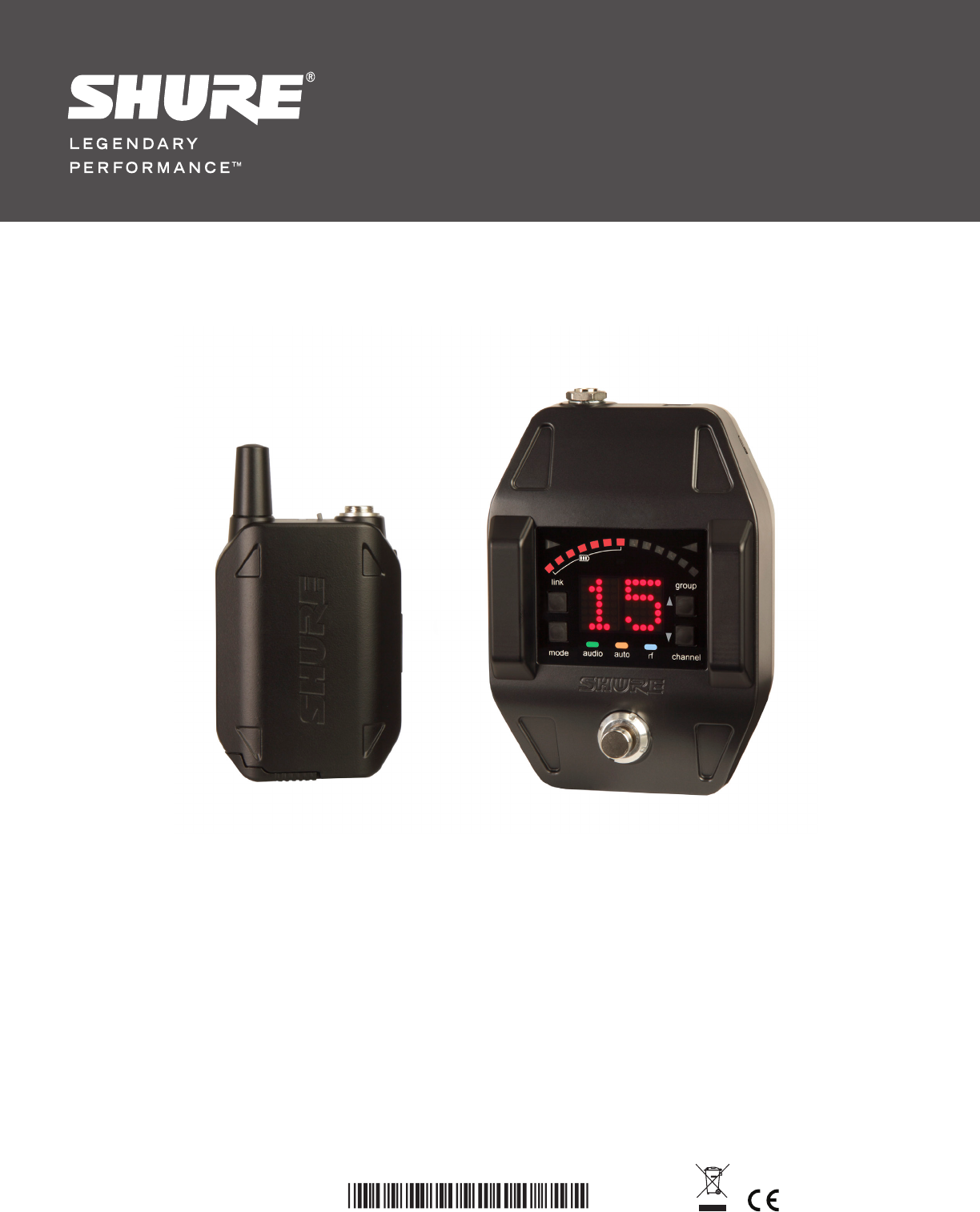
User Guide
Shure Incorporated Confidential
© 2013 Shure Incorporated
27A20637 (Rev. Preliminary) Printed in U.S.A.
Please Note: The following document layout is preliminary to identify,
organize, and prioritize content. All copy including titles, descriptions,
photos, specifications, and artwork are not final at this time.
GLXD6 Guitar Pedal Receiver / Tuner
DRAFT
3.4.13
DRAFT
3.4.13

IMPORTANT SAFETY INSTRUCTIONS
1. READ these instructions.
2. KEEP these instructions.
3. HEED all warnings.
4. FOLLOW all instructions.
5. DO NOT use this apparatus near water.
6. CLEAN ONLY with dry cloth.
7. DO NOT block any ventilation openings. Allow sufficient distances for adequate ventila-
tion and install in accordance with the manufacturer’s instructions.
8. DO NOT install near any heat sources such as open flames, radiators, heat registers,
stoves, or other apparatus (including amplifiers) that produce heat. Do not place any open
flame sources on the product.
9. DO NOT defeat the safety purpose of the polarized or groundingtype plug. A polarized
plug has two blades with one wider than the other. A grounding type plug has two blades
and a third grounding prong. The wider blade or the third prong are provided for your
safety. If the provided plug does not fit into your outlet, consult an electrician for replace-
ment of the obsolete outlet.
10. PROTECT the power cord from being walked on or pinched, particularly at plugs, conve-
nience receptacles, and the point where they exit from the apparatus.
11. ONLY USE attachments/accessories specified by the manufacturer.
12. USE only with a cart, stand, tripod, bracket, or table specified by the manu-
facturer, or sold with the apparatus. When a cart is used, use caution when
moving the cart/apparatus combination to avoid injury from tip-over.
13. UNPLUG this apparatus during lightning storms or when unused for long
periods of time.
14. REFER all servicing to qualified service personnel. Servicing is required when the ap-
paratus has been damaged in any way, such as power supply cord or plug is damaged,
liquid has been spilled or objects have fallen into the apparatus, the apparatus has been
exposed to rain or moisture, does not operate normally, or has been dropped.
15. DO NOT expose the apparatus to dripping and splashing. DO NOT put objects filled with
liquids, such as vases, on the apparatus.
16. The MAINS plug or an appliance coupler shall remain readily operable.
17. The airborne noise of the Apparatus does not exceed 70dB (A).
18. Apparatus with CLASS I construction shall be connected to a MAINS socket outlet with a
protective earthing connection.
19. To reduce the risk of fire or electric shock, do not expose this apparatus to rain or
moisture.
20. Do not attempt to modify this product. Doing so could result in personal injury and/or
product failure.
21. Operate this product within its specified operating temperature range.
This symbol indicates that dangerous voltage constituting a risk of
electric shock is present within this unit.
This symbol indicates that there are important operating and mainte-
nance instructions in the literature accompanying this unit.
WARNING: This product contains a chemical known to the State of California to cause cancer and birth
defects or other reproductive harm.
WARNING: Battery packs shall not be exposed to excessive heat such as sunshine, fire, or the like.
WARNING
• Battery packs may explode or release toxic materials. Risk of fire or burns. Do not open, crush, modify, disassemble, heat above 140°F
(60°C), or incinerate
• Follow instructions from manufacturer
• Never put batteries in mouth. If swallowed, contact your physician or local poison control center
• Do not short circuit; may cause burns or catch fire
• Do not charge or use battery packs with other than specified Shure products
• Dispose of battery packs properly. Check with local vendor for proper disposal of used battery packs
WARNING: Danger of explosion if battery incorrectly replaced. Operate only with Shure compatible batteries.
Note:
• This equipment is intended to be used in professional audio applications.
• EMC conformance is based on the use of supplied and recommended cable types. The use of other cable types may degrade EMC
performance.
• Use this battery charger only with the Shure charging modules and battery packs for which it is designed. Use with other than the
specified modules and battery packs may increase the risk of fire or explosion.
• Changes or modifications not expressly approved by Shure Incorporated could void your authority to operate this equipment.
Note: Use only with the included power supply or a Shure-approved equivalent.
DRAFT
3.4.13
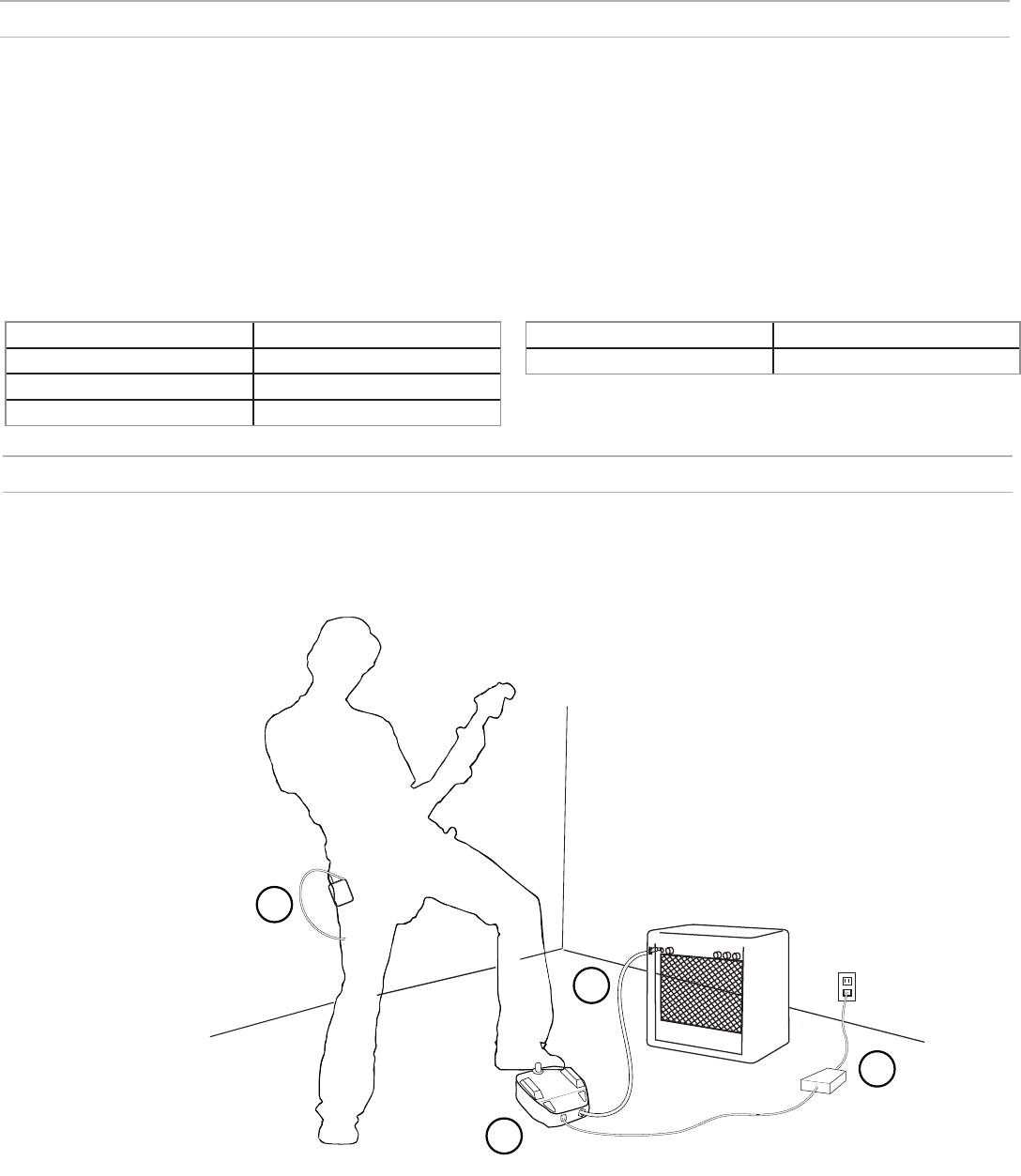
2
3
4
1
4
System Overview
GLX-D delivers superior digital audio in a compact, easy to use wireless system. More audio channels are placed on-air by taking advantage of the
globally available 2.4 GHz spectrum. The compact low-profile design easily fits into pedalboard configurations. Built-in chromatic tuner simplifies setups
while offering flexible tuning options. Advanced frequency hopping technology detects interference and automatically switches to a clear backup channel
to prevent audio dropouts. Channel scanning finds the best receiver channel for wireless audio and automatically links to transmitter.
• Clear digital audio
• Operates in 2.4 GHz spectrum, available worldwide.
• Compact rugged metal construction
• Compatible with standard 9 V DC power supplies (250 mA minimum)
• Rechargeable transmitter batteries deliver cost-efficiency and up to 16
hours of runtime
• Adjustable transmitter gain to optimize audio signal
• Automatically detects and avoids interference to preserve audio quality
• RF back-channel for remote control of transmitter functions
• Automatic transmitter power-off to conserve battery life when
transmitter is not in use.
Included Components
Shure Rechargeable Battery SB902
Micro USB Battery Charger SBC-USB
Power Supply PS23
Premium Guitar Cable WA305
Optional Accessories
Car Battery Charger SBC-CAR
Docking Battery Charger SBC-902
Quick Start
To reduce set up time, the transmitter and receiver automatically link to form an audio channel the first time they are powered on and never have to be
linked again.
Note: If using multiple effects pedals, place the receiver pedal first in the signal chain.
Step ①
Connect power supply to the receiver and plug the power cord into an
AC power source.
Step ②
Connect the transmitter to the instrument and turn on the transmitter.
Step ③
Connect receiver audio output to an amplifier or mixer. Turn on the
receiver and verify the blue RF LED is on.
Step ④
Check the audio and adjust the gain if necessary.
DRAFT
3.4.13
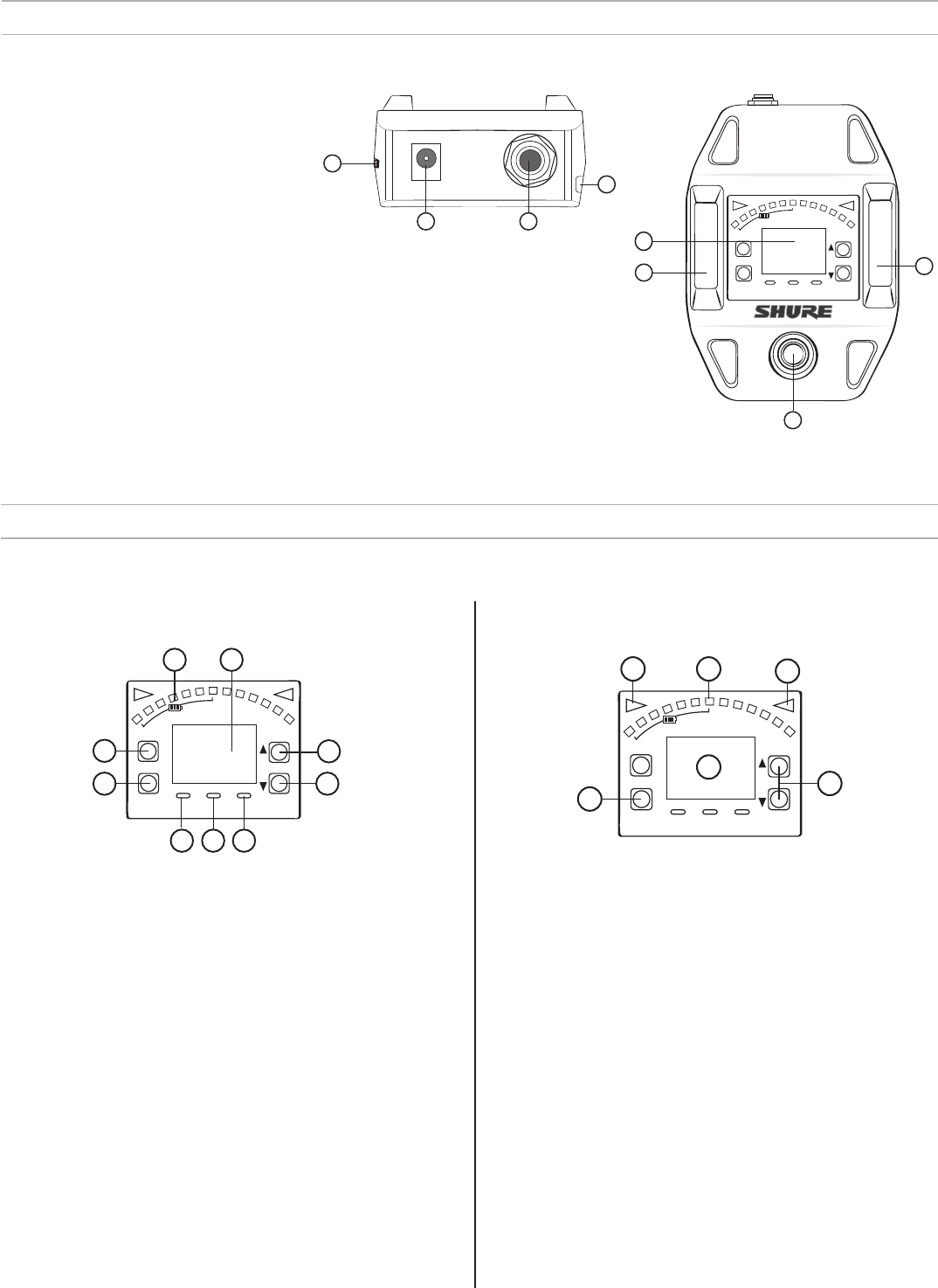
5
Guitar Pedal Receiver Overview
Display Screen, Indicators, and Controls
The controls and display offer specific functionality depending on which mode is selected:
① Power Switch
Turns power on or off.
② DC Power Connector
Connect DC power supply (9 to 15 V DC,
250 mA min.)
Note: Compatible with positive tip or negative tip
power supplies.
③ Audio Output Jack
Connect to amplifier or mixer.
Note: If using multiple effects pedals, place the
receiver pedal first in the signal chain.
④ USB Port
⑤ Display
Displays receiver and tuner settings.
⑥ Antenna
Carries wireless signal, 2 per receiver.
⑦ Footswitch
Press to select receiver or tuner mode.
Tuner Mode
2 3
1
4
6
link
mode autoaudio rf channel
group
6
7
5
rf channel
group
auto
link
mode audio
1
3
4
56
2
7
8
9
rf channel
group
auto
link
mode audio
1
56
23
4
① Transmitter Battery Meter
Illuminated segments indicate
remaining battery life
② Display
Group
Channel
LK (controls locked)
UN (controls unlocked)
-- (frequency not available)
③ Link Button
Press to manually link receiver
to a transmitter or activate the
remote ID function
④ Mode Button
Press to enable audio gain
adjustment. Use ▲ ▼ buttons to
adjust gain.
⑤ Audio LED
Illumination corresponds to
audio level.
⑥ Auto LED
Illuminates if selected
group has backup channels
available.
⑦ RF LED
• ON = Linked transmitter
is on
• Flashing = Searching for
transmitter
• OFF = Linked transmitter
off or transmitter unlinked
⑧ Channel Button
Press to select and edit
channel
⑨ Group Button
Press to select and edit group
① Flat Indicator
Illuminates when note is flat.
② Tuning Bar Display
LEDs illuminate to indicate
tuning deviation.
③ Sharp Indicator
Illuminates when note is sharp.
④ Note Display
Displays the name of the note
or (--) if the tuner is idle.
⑤ Mode Button
Press to enter tuner menu
settings.
⑥ Arrow Buttons
Use ▲ ▼ buttons to select and
edit menu settings.
Receiver Mode
DRAFT
3.4.13
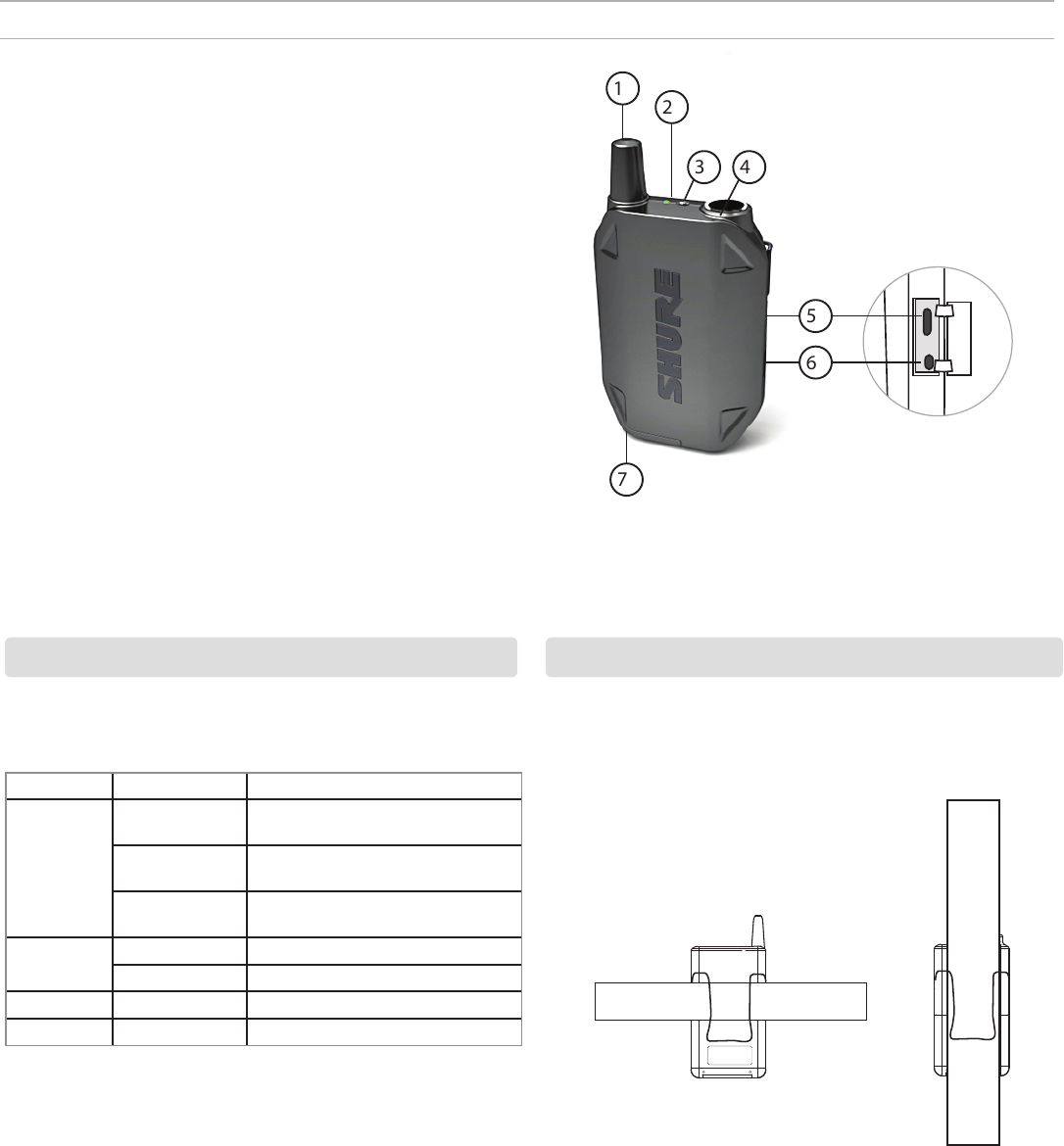
6
Bodypack Transmitter
Transmitter Status LED
① Antenna
Carries wireless signal.
② Status LED
Indicates transmitter status.
③ Power Switch
Turns the transmitter on/off.
④ TA4M Input Jack
Connects to a 4-Pin mini connector (TA4F) microphone or instrument
cable.
⑤ Micro USB Charging Port
Connection for battery charging.
⑥ Link Button
• Press and hold within 5 seconds of power-on to manually link with
receiver
• Press momentarily to activate Remote ID function to a linked
receiver
⑦ Battery Compartment
Holds Shure rechargeable battery.
Wearing the Bodypack Transmitter
Clip the transmitter to a belt or slide a guitar strap through the transmitter
clip as shown.
For best results, the belt should be pressed against the base of the clip.
LED is green during normal operation.
LED color or flashing indicates a change in transmitter status as shown in
the following table:
Color State Status
Green Flashing (slow) Transmitter attempting relink with
receiver
Flashing (fast) Unlinked transmitter searching for
receiver
Flashes 3 times indicates locked transmitter when
power switch is pressed
Red On battery life < 1 hour
Flashing battery life < 30 minutes
Red/Green Flashing remote ID active
Amber Flashing battery error, replace battery
DRAFT
3.4.13
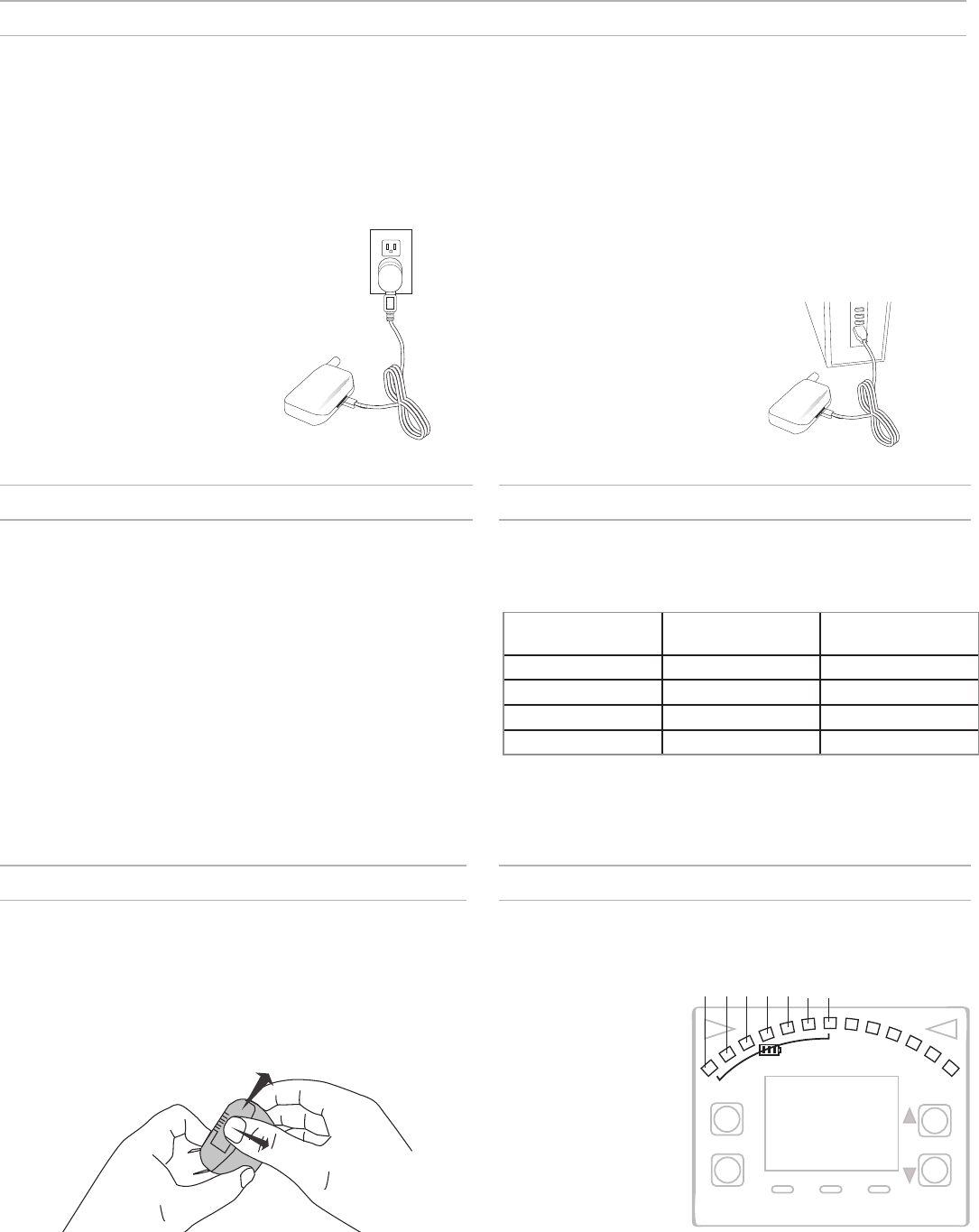
7
Batteries and Charging
LED Status During Charging
The following LED states indicate battery status when the transmitter is
connected to a charger:
• Green = charging complete
• Green Flashing = battery charge > 90%
• Red = battery charging
• Amber Flashing = battery error, replace battery
Charging Times and Transmitter Runtimes
Use the following table to determine approximate battery runtime based
on the duration of charging time. Times shown are in hours and minutes.
Note: Batteries charge faster when using an AC powered charger versus a USB connection.
AC Power Source
Charging
USB Connection
Charging
Transmitter Runtime
0:15 0:30 up to 1:30
0:30 1:00 up to 3:00
1:00 2:00 up to 6:00
3:00 4:00 up to 16:00*
*Storage time or excessive heat will reduce maximum runtime.
Note: GLX-D transmitters automatically power-off after approximately 1 hour to conserve battery
life if the signal from a linked receiver is not detected.
Installing Transmitter Batteries
Bodypack Transmitter
1. Move the locking lever to the open position and slide the battery door
open.
2. Place the battery into the transmitter.
3. Close the battery door and slide door to engage the latch.
GLX-D transmitters are powered by Shure SB902 lithium-ion rechargeable batteries. Advanced battery chemistry maximizes runtimes with zero memory
effects, eliminating the need to discharge batteries prior to charging.
When not in use, recommended battery storage temperature is 10°C (50°F) to 25°C (77°F).
Note: The transmitter will not pass RF or audio signals when connected to the charging cable.
The following battery charging options are available:
link
mode autoaudio rf channel
group
①②③④⑤⑥⑦
Transmitter Battery Meter
The number of segments illuminated on the meter indicates the remaining
battery life for a linked transmitter:
① = > 30 min
② = > 2 hours
③ = > 4 hours
④ = > 6 hours
⑤ = > 8 hours
⑥ = > 10 hours
⑦ = > 12 hours
Note: The LEDs will cycle on/
off while battery life is being
calculated.
Charging from a USB PortCharging from an AC Power Source
For fastest battery charging, use an AC
power source to charge the battery.
1. Plug the charging cable into the
charging port on the transmitter.
2. Plug the charging cable into an AC
power source.
The USB charger is a convenient option for charging the battery using
power from a standard USB port commonly found on computers and other
devices.
1. Plug the USB charging cable
into the charging port on the
transmitter.
2. Plug the cable into a standard
USB port.
DRAFT
3.4.13
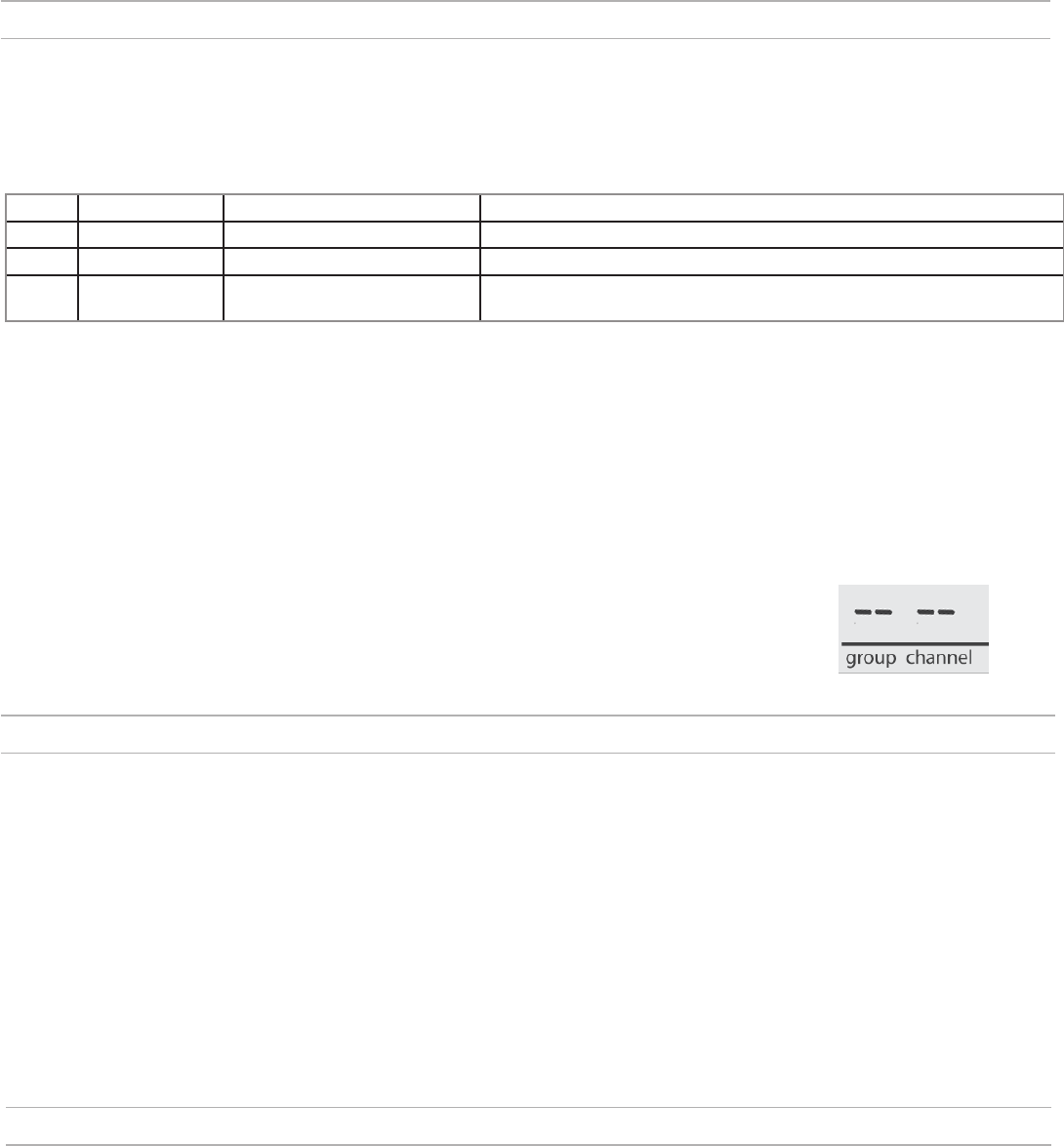
8
Multiple Receiver Systems
If several channels of wireless audio are needed, up to 8 GLX-D receivers can operate simultaneously in the 2.4 GHz spectrum. For ease of set up,
available frequencies are divided into three groups based on the number of receivers supported.
All receivers in the system must be set to the same group. To select a group, determine the total number of receivers in the system (channel count), and
then select the appropriate group.
Note: To maximize the number of receivers on-air, Group 3 does not offer backup frequencies. Group 3 should only be used in controlled Wi-Fi environments to prevent interference from unexpected Wi-
Fi devices.
Group Channel Count Backup Frequencies Available? Notes
1 Up to 4 Yes Initial Factory Setting.
2 Up to 5 Yes Best Group to use if you experience interference.
3Up to 8 No Only use Group 3 in controlled Wi-Fi environments because there are no backup
frequencies to avoid interference.
Note: If you experience interference, reduce transmitter to receiver distance and set all GLX-D systems to group 2, which is the most robust wireless group.
See "Tips to Improve Wireless System Performance" section for additional steps if needed.
Setting Up Receivers and Transmitters
Note: Before beginning, turn off all receivers and transmitters. Turn on and set up each receiver/transmitter pair individually to prevent
cross-linking.
1. Turn on the first receiver.
2. Press and hold the group button to select a group (if necessary) or if the group is already set, press the
channel button to scan for the best available channel.
3. Turn on the first transmitter. The blue RF light will illuminate when a link is established.
Repeat steps 1-3 for each additional receiver and transmitter. Remember to set each receiver to the same
group.
Manually Selecting a Group and Channel
Specific groups and channels can be assigned to the receiver instead of using the automatic scan function.
Note: Group 3 should only be used in controlled Wi-Fi environments to prevent interference from unexpected Wi-Fi devices.
Manually Linking a Transmitter to a Receiver
Use the manual linking option to change the transmitter linked to a receiver. For example, changing the linked transmitter from a bodypack to a
handheld.
Use the following steps to manually change the transmitter linked to a receiver:
1. Turn on the transmitter: Within 5 seconds, press and hold the LINK button until the transmitter LED begins to flash green.
2. Press and hold the link button on the receiver: The blue rf LED will flash, and then remain on when the link has been established.
3. Test the audio to verify the link and adjust the gain if necessary.
Note: Dashes appearing on the group
and channel display during a channel
scan indicate that frequencies are
not available in the selected group.
Choose a group that supports more
receivers and repeat the set up steps.
Selecting a Group
1. Press and hold the group button for 2 seconds until the group
display flashes.
2. Press the group button to scroll through the available groups.
3. The receiver will automatically save the selected group.
Selecting a Channel
1. Press and hold the channel button for 2 seconds until the channel
display flashes.
2. Press the channel button to scroll through the available channels.
3. The receiver will automatically save the selected channel.
Note: A double dash symbol-- displayed on the receiver screen during a channel scan indicates
that there are no available channels within the selected group. Choose a group with more
channels and repeat set up steps.
DRAFT
3.4.13

9
2.4 GHz Spectrum Overview
GLX-D operates within the 2.4GHz ISM band which is utilized by for Wi-Fi, Bluetooth, and other wireless. The benefit of 2.4GHz is that it’s one global
band that can be used anywhere in the world, license free.
Overcoming the Challenges of 2.4GHz
The challenge of 2.4GHz is that Wi-Fi traffic can be
unpredictable. GLX-D meets these challenges in
the following ways:
• Prioritizes and transmits on the best 3
frequencies per channel (choosing from a
pool of 6 frequencies across the 2.4GHz
band)
• Repeats the most important information such
that one frequency can be taken out entirely
without audio interruption
• Continuously scans during usage to rank
all frequencies (both current and backup
frequencies)
• Seamlessly moves away from interference to
backup frequencies without audio interruption
Coexisting with Wi-Fi
GLX-D avoids continuous Wi-Fi traffic by
scanning the entire 2.4GHz environment
and selecting the 3 best frequencies to
transmit on. The result of this is reliable
performance for your GLX-D wireless
system as well as avoiding Wi-Fi
transmissions which may be important as
well.
“Bursting” Wi-Fi is harder to detect as
it is periodic; however, because GLX-D
repeats the most important information
even if these bursts are very high-level,
they don’t have an effect on your audio
performance.
Challenging Wireless
Environments
Some environments are more difficult
than others for 2.4 GHz wireless system
performance. The simplest solution in
many cases is to reduce the transmitter
to receiver distance such as placing the
receivers on the stage with a clear line of
sight.
Challenging environments include:
• Outdoors
• Very high ceilings
• 3 or more GLX-D receivers in use
• Strong Wi-Fi presence
• Non-Shure 2.4 GHz systems in use
Tips to Improve Wireless System Performance
If you encounter interference or dropouts, try the following suggestions:
• Scan for the best available channel (press the channel button)
• Reposition the receiver so there is nothing obstructing a line of
sight to the transmitter (including the audience)
• Keep the transmitter and receiver more than 2 meters (6 feet)
apart
• Keep transmitter to receiver distance within 60 meters (200 feet) -
place receivers on-stage within line of sight if possible
• Remove or relocate nearby sources of wireless interference,
such as Wi-Fi devices or hotspots, cell phones, two-way radios,
computers, media players, and digital signal processors
• Disable non-essential Wi-Fi/bluetooth devices and avoid heavy
Wi-Fi traffic activities such as downloading large files or viewing
a movie.
• Locate GLX-D receivers away from non-Shure 2.4 GHz receivers
• Avoid placing transmitter and receiver where metal or other dense
materials may be present
• Recharge or replace the transmitter battery
• Keep transmitters more than 2 meters (6 feet) apart
Note: GLX-D transmitters closer than 6 inches (15 cm) to other non-GLX-D
transmitters may cause audible noise in that transmitter
• During sound check, mark trouble spots and ask presenters or
performers to avoid those areas
2.4 GHz Frequency Tables
The following table lists receiver frequencies, channels, and latency for each group:
Group 1: Channels 1-4 (latency = 3.9 ms)
1/1 1/2 1/3 1/4
2424 2418 2411 2405
2425 2419 2413 2406
2442 2448 2430 2436
2443 2450 2431 2437
2462 2469 2476 2455
2464 2471 2477 2457
Group 2: Channels 1-5 (latency = 7.3 ms)
2/1 2/2 2/3 2/4 2/5
2423 2404 2417 2417 2437
2424 2405 2418 2418 2438
2443 2426 2451 2451 2462
2444 2427 2452 2452 2463
2473 2456 2468 2468 2477
2474 2457 2469 2469 2478
Group 3: Channels 1-6 (latency = 7.3 ms)
3/1 3/2 3/3 3/4 3/5 3/6
2415 2422 2426 2447 2409 2431
2416 2423 2427 2448 2451 2462
2443 2439 2457 2468 2452 2463
DRAFT
3.4.13
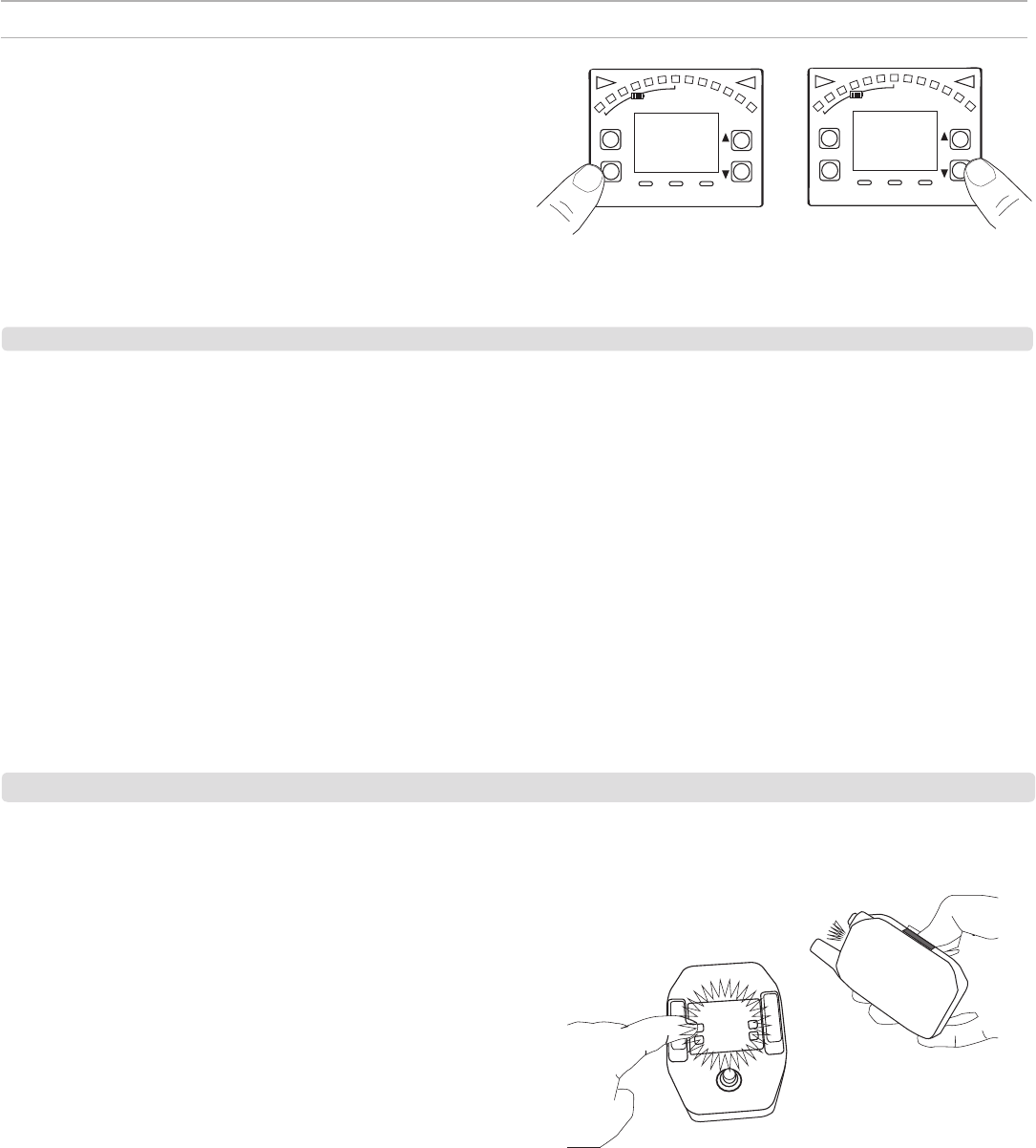
10
Receiver Operation
• Lock status is not changed by power cycles
• Tuner functionality and editing remains available
• The receiver power switch does not lock
Locking the Receiver Controls
Simultaneously press and hold the group and channel buttons to lock or
unlock the receiver.
• LK is displayed if a locked control is pressed
• UN is displayed momentarily to confirm the unlock command
link
mode autoaudio rf channel
group
rf channel
group
auto
link
mode audio
d B - 9
Use the Remote ID feature to identify linked transmitter and receiver pairs. When Remote ID is active, the receiver LCD will blink and display ID. The
status LED of the corresponding transmitter will alternately flash red and green for approximately 45 seconds.
Audio Gain Adjustment
Transmitter gain has an adjustment range from -20 dB to +40 dB, in 1 dB
increments.
Tip: Try the 0 dB (unity gain) setting as a starting point, and then make gain adjustments if necessary.
1. Press and hold the mode button on the receiver until dB appears on the
display.
2. Press the up/down arrows to adjust the gain.
Note: The intensity of the green audio LED corresponds to the audio level.
The controls of the receiver and transmitter can be locked to prevent accidental or unauthorized changes to settings.
The following parameters are not affected by locking the controls:
To activate Remote ID:
1. Momentarily press the link button on the transmitter or receiver.
2. The display of the linked receiver will blink and show ID and the status
LED on the linked transmitter will flash red/green.
3. To exit Remote ID mode, momentarily press the link button or allow the
function to timeout.
I D
Locking the Transmitter Power Switch
Starting with the transmitter set to off, press and hold the LINK button
while turning on the transmitter. Repeat sequence to unlock.
Note: The transmitter status LED will flash red/green if a locked switch is set to the off position.
Locking and Unlocking the Controls
Remote ID
DRAFT
3.4.13

11
Indicator: Needle or Strobe
Output: Live or Mute
Detune
Needle
A single LED will illuminate on
the tuning bar to indicate sharp
or flat. The green center LED will
illuminate when the note is in tune.
Strobe
A sequence of three LEDs will
travel across the tuning bar in the
direction of sharp or flat. The LEDs
will remain stationary when the
note is in tune.
Frequency Offset
b0
b1
b2
The tuner indicator can be set to display a needle style or strobe style.
The audio output can be set to Live or Mute in tuning mode:
• Live: Audio is passed to the amplifier or mixer
• Mute: Audio is muted at the pedal output
The Detune feature can detect instruments that have been detuned up to
2 semitones (half steps).
The display will indicate the detuning as follows:
Adds sharp or flat symbols to the display of non-natural notes.
Frequency Offset adjusts the reference frequency from A440. The range
of adjustment is 432 Hz to 447 Hz in 1 Hz increments.
When adjusting the frequency, the last 2 digits of the value will be show.
For example, "32" would appear on the display when the frequency has
been set to 432 Hz.
Note: Two dots appear in the display as a reminder that the reference frequency is offset.
A440 447 Hz432 Hz
Display Brightness
The receiver has a built-in light sensor to automatically adjust the display
brightness.
To manually adjust the brightness choose one of the following settings:
*1
*A*2*3
L....i....v....e M....u....t....e
N..e..e..d..l..e S..t..r..o..b..e
#b b#
*A = automatic *1 = low *2 = medium *3 = high
Tuner Options
• Indicator: Needle or Strobe
• Output: Live or Mute
• Display Brightness
• Detune
• Sharps and Flats
• Frequency Offset
Selecting and Editing Tuner Menu Settings
Use the following buttons to select and edit the tuner
menu settings:
• Use the mode button access the menu and to
scroll between menu settings
• Use the Use ▲ ▼ buttons to change a menu
parameter
• Use the footswitch to enter and save parameter
changes
Tuner Menu
Enter tuner mode by pressing the footswitch. In tuner mode, the controls will only affect tuner functions. Receiver RF setting will not be affected.
Note: Indicator and Output settings are displayed in a scroll from left to right.
Note: Indicator and Output settings are displayed in a scroll from left to right.
rf channel
group
auto
link
mode
M...e...n...u
Sharps and Flats
Sharps and Flats Flats only Sharps only
b0 = Standard Tuning b1 = 1 Semitone b2 = 2 Semitones
Note: Two dots appear in the display as a reminder that the pedal is detuned.
DRAFT
3.4.13
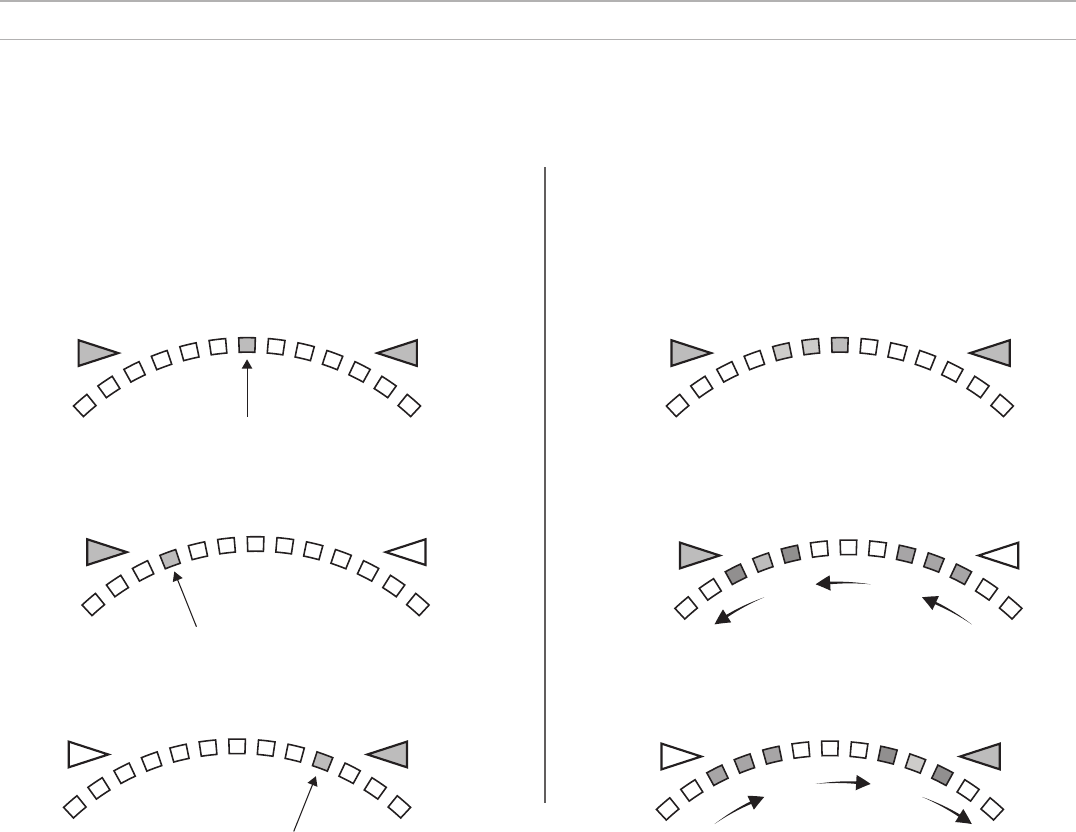
I
I
I
I
I
I
I
I
I
I
I
I
I
I
I
I
I
I
I
I
I
I
I
I
I
I
I
I
I
I
I
I
I
I
I
I
I
I
I
I
I
I
I
I
I
I
I
I
I
I
I
I
I
I
I
I
I
I
I
I
I
I
I
I
I
I
I
I
I
I
I
I
I
I
I
I
I
I
I
I
I
I
I
I
I
I
I
I
I
I
I
I
I
I
I
I
I
I
I
I
I
I
I
I
I
I
I
I
I
I
I
I
I
I
I
I
I
I
I
I
I
I
I
I
I
I
I
I
I
I
I
I
I
I
I
I
I
I
I
I
I
I
I
I
I
I
I
I
I
I
I
I
I
I
I
I
I
I
I
I
I
I
I
I
I
I
I
I
I
I
I
I
I
I
I
I
I
I
I
I
I
I
I
I
I
I
I
I
I
I
I
I
I
I
I
I
I
I
I
I
I
I
I
I
I
I
I
I
I
I
I
I
I
I
I
I
I
I
I
I
I
I
I
I
I
I
I
I
I
I
I
I
I
I
I
I
I
I
I
I
I
I
I
I
I
I
I
I
12
Using the Tuner
1. Press the footswitch to enter tuner mode.
2. Play each note individually. The display shows the name of the note.
3. Adjust tuning until both indicators illuminate and the needle or strobe indicate that tuning is correct.
Needle Mode
Both tuning indicators and the center green segment will
illuminate when the note is in tune.
In Tune
Flat
Sharp
Strobe Mode
Both tuning indicators will illuminate and the strobe
segments will remain stationary when the note is in tune.
In Tune
Flat
Sharp
DRAFT
3.4.13

13
Troubleshooting
Issue Indicator Status Solution
No sound or faint sound Receiver RF LED on • Verify all sound system connections or adjust gain as needed (see
Adjusting Gain)
• Verify that the receiver is connected to mixer/amplifier
Receiver RF LED off • Turn on transmitter
• Make sure the batteries are installed correctly
• Link transmitter and receiver (see Linking topic)
• Charge or change transmitter battery
Receiver LCD screen off • Make sure AC adapter is securely plugged into electrical outlet.
• Make sure receiver is powered on.
Transmitter indicator LED flashing red Charge or change transmitter battery
Transmitter plugged into charger. Disconnect transmitter from charger.
Audio artifacts or dropouts rf LED flickering or off • Change receiver and transmitter to a different group and/or channel.
• Identify nearby sources of interference (cell phones, Wi-Fi access points,
signal processor, etc...) and shutdown or remove source.
• Charge or changer transmitter battery
• Ensure that receiver and transmitter are positioned within system
parameters
• System must be set up within recommended range and receiver kept away
from metallic surfaces.
• Transmitter must be used in line of sight from receiver for optimal sound
Distortion OL indicator appears on receiver LCD Reduce transmitter gain (see Gain Adjustment).
Sound level variations
when switching to different
sources
N/A Adjust transmitter gain as necessary (see Gain Adjustment).
Receiver/transmitter won't
turn off
Transmitter LED flashing rapidly Controls locked. See Locking and Unlocking Controls.
Receiver gain control can-
not be adjusted
N/A Check transmitter. Transmitter must be on to enable gain changes.
Receiver controls cannot
be adjusted
LK shown on receiver display when but-
tons are pressed
Controls locked. See Locking and Unlocking Controls.
Transmitter ID function
does not respond.
Transmitter LED flashes green 3 times Controls locked. See Locking and Unlocking Controls.
Transmitter information
does not appear on the
Receiver LCD
N/A Linked transmitter is off or the receiver is not linked to a transmitter.
Transmitter powers off af-
ter 1 hour.
Transmitter status LED off GLX-D transmitters automatically power-off after 1 hour to conserve battery
life if the signal from a linked receiver is not detected. Make sure that linked
receiver is turned on.
Resetting Components
Resetting the Receiver
Restores the receiver to the following factory settings:
• Gain level = default
• Controls = unlocked
Press and hold the link button while turning on the receiver power until
the LCD displays RE.
Note: When reset is complete, the receiver will automatically initiate linking to search for a
transmitter. Press and hold the transmitter link button within five seconds of powering-on to
complete the link.
Resetting the Transmitter
Restores the transmitter to the following factory settings:
• Controls = unlocked
Press and hold the transmitter link button while turning on the transmitter
until power LED goes off.
When the link button is released, the transmitter will automatically initiate
linking to find an available receiver. Press the link button on an available
receiver to relink.
Use the reset function if it is necessary to restore the transmitter or receiver to their factory settings.
DRAFT
3.4.13
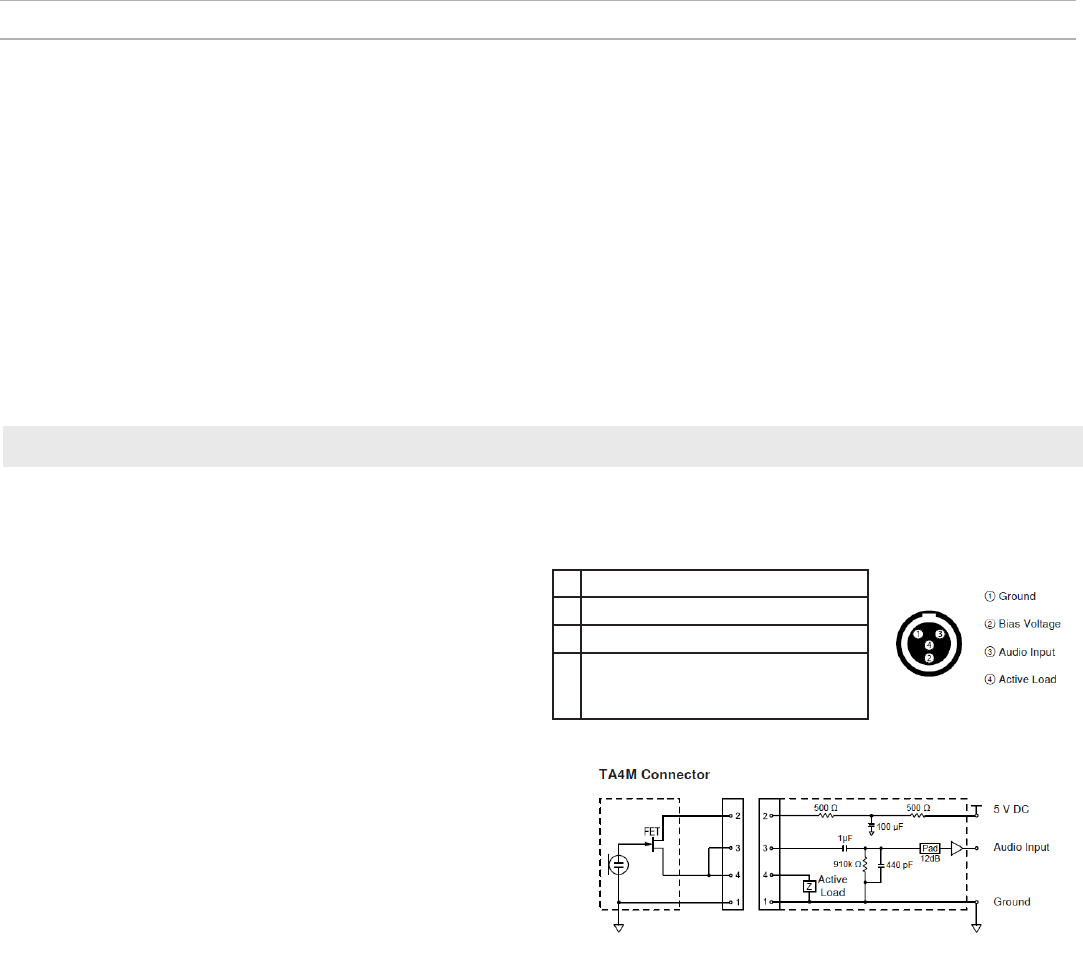
14
Specifications
GLXD1
Dimensions
90.4 x 64.5 x 22.9 mm (3.56 x 2.54 x 0.90 in.), H x W x D (without
antenna)
Power Requirements
3.7 V Rechargeable Li-Ion
Housing
Cast Metal, Black Powdercoat
Input Impedance
900 kΩ
RF Output Power
10 mW E.I.R.P. max
Transmitter Input
Connector
4-Pin male mini connector (TA4M)
Configuration
Unbalanced
Maximum Input Level
1 kHz at 1% THD
+8.4 dBV (7.5 Vp-p)
Tuning Bandwidth
2400–2483.5 MHz
Antenna Type
Internal Monopole
Pin Assignments
TA4M
1ground (cable shield)
2+ 5 V Bias
3audio
4Tied through active load to ground
(On instrument adapter cable, pin 4
floats)
Working Range
60 m (200 ft) typical
Note: Actual range depends on RF signal absorption, reflection and interference.
Transmit Mode
Frequency Hopping
Audio Frequency Response
20 Hz – 20 kHz
Dynamic Range
120 dB, A-weighted
Latency
Total Harmonic Distortion
0.2%, typical
RF Output Power
10 mW E.I.R.P. max
Operating Temperature Range
-18°C (0°F) to 57°C (135°F)
Note: Battery characteristics may limit this range.
Storage Temperature Range
-29°C (-20°F) to 74°C (165°F)
Polarity
Positive pressure on microphone diaphragm (or positive voltage applied
to tip of WA302 phone plug) produces positive voltage on pin 2 (with
respect to pin 3 of low-impedance output) and the tip of the high imped-
ance 1/4-inch output.
Battery Life
Up to 16 hours
RF Sensitivity
-88 dBm, typical
DRAFT
3.4.13
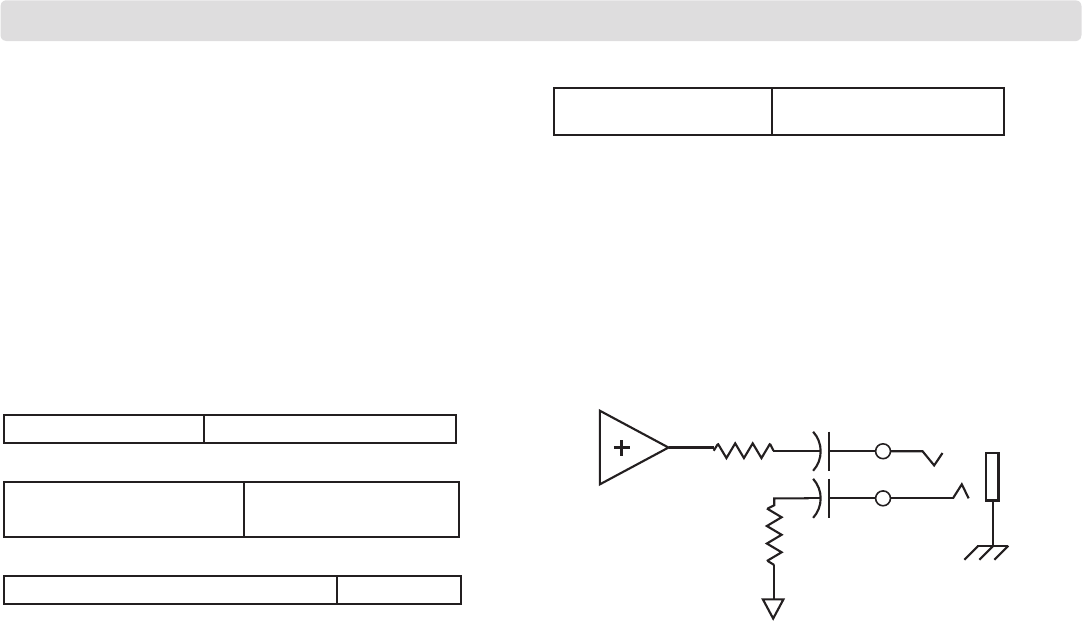
15
Dimensions
46 x 95 x 133 mm (1.8 x 3.7 x 5.2 in.), H x W x D
Weight
504 g (17.8 oz.)
Housing
Cast Metal, Black Powdercoat
Power Requirements
9 to 15 V DC (negative ground), 250 mA
Spurious Rejection
>35 dB, typical
Gain Adjustment Range
-20 to 40 dB in 1 dB steps
Configuration
6.35 mm (1/4") output Impedance balanced
Impedance
6.35 mm (1/4") output 100 Ω
(50 Ω, Unbalanced)
Maximum Audio Output Level
6.35 mm (1/4") connector (into 3 kΩ load) +8.5 dBV
GLXD6
Pin Assignments
6.35 mm (1/4") connector Tip=audio, Ring=no audio,
Sleeve=ground
Receiver Antenna Input
Impedance
50 Ω
Antenna Type
½ Wave Sleeve Dipole, non-removable
Maximum Input Level
−20 dBm
Output Connections
50 Ω
50 Ω 22 µF
22µF
DRAFT
3.4.13

16
Certifications
This device complies with part 15 of the FCC Rules. Operation is subject to the following two conditions: (1) This device may not cause harmful
interference, and (2) this device must accept any interference received, including interference that may cause undesired operation.
Meets requirements of the following standards: EN 300 328, EN 301 489 Parts 1 and 9, EN60065.
Meets essential requirements of the following European Directives:
• R&TTE Directive 99/5/EC
• WEEE Directive 2002/96/EC, as amended by 2008/34/EC
• RoHS Directive 2002/95/EC, as amended by 2008/35/EC
Note: Please follow your regional recycling scheme for batteries and electronic waste
Certified by IC in Canada under RSS-210 and RSS-GEN.
IC: 616A-GLXD1, 616A-GLXD6
Certified under FCC Part 15.
FCC ID: DD4GLXD1, DD4GLXD6
This Class B digital apparatus complies with Canadian ICES-003. Cet appareil numérique de la classe B est conforme à la norme NMB-003 du Canada.
This device complies with Industry Canada licence-exempt RSS standard(s). Operation of this device is subject to the following two conditions: (1) this
device may not cause interference, and (2) this device must accept any interference, including interference that may cause undesired operation of the
device.
Le présent appareil est conforme aux CNR d'Industrie Canada applicables aux appareils radio exempts de licence. L'exploitation est autorisée aux deux
conditions suivantes : (1) l'appareil ne doit pas produire de brouillage, et (2) l'utilisateur de l'appareil doit accepter tout brouillage radioélectrique subi,
même si le brouillage est susceptible d'en compromettre le fonctionnement.
The CE Declaration of Conformity can be obtained from Shure Incorporated or any of its European representatives. For contact information please visit
www.shure.com
The CE Declaration of Conformity can be obtained from: www.shure.com/europe/compliance
Authorized European representative:
Shure Europe GmbH
Headquarters Europe, Middle East & Africa
Department: EMEA Approval
Jakob-Dieffenbacher-Str. 12
75031 Eppingen, Germany
Phone: 49-7262-92 49 0
Fax: 49-7262-92 49 11 4
Email: EMEAsupport@shure.de
Information to the user
This equipment has been tested and found to comply with the limits for a Class B digital device, pursuant to Part 15 of the FCC Rules. These limits are
designed to provide reasonable protection against harmful interference in a residential installation. This equipment generates uses and can radiate radio
frequency energy and, if not installed and used in accordance with the instructions, may cause harmful interference to radio communications. However,
there is no guarantee that interference will not occur in a particular installation. If this equipment does cause harmful interference to radio or television
reception, which can be determined by turning the equipment off and on, the user is encouraged to try to correct the interference by one or more of the
following measures:
• Reorient or relocate the receiving antenna.
• Increase the separation between the equipment and the receiver.
• Connect the equipment to an outlet on a circuit different from that to which the receiver is connected.
• Consult the dealer or an experienced radio/TV technician for help.
DRAFT
3.4.13

17
PT. GOSHEN SWARA INDONESIA
Kompleks Harco Mangga Dua Blok L No. 35 Jakarta Pusat
2013 Shure Incorporated
I.16.GSI31.00501.0211
Europe, Middle East, Africa:
Shure Europe GmbH
Jakob-Dieffenbacher-Str. 12,
75031 Eppingen, Germany
Phone: 49-7262-92490
Fax: 49-7262-9249114
Email: info@shure.de
DRAFT
3.4.13